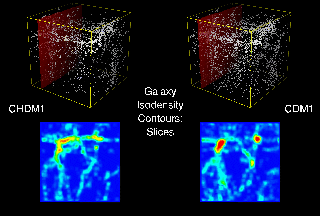![[Currents header graphic]](/homeart/currents_header.gif)
![[Currents header graphic]](/homeart/currents_header.gif)
December 15, 1997

|
| One result of a supercomputer simulation
by Joel Primack and his team
|
By Robert Irion
Colorful clumps and chains of galaxies zoom past as the viewer flies through a chunk of the cosmos. The latest sci-fi epic from Hollywood? No, it's serious scientific research, which the country's top astrophysics journal soon will publish in video form.
The video (view still images) displays simulations of the evolution of galactic structure in the universe, carried out on speedy supercomputers. An IBM Power Visualization System--the same machine that adds special effects to some of those Hollywood epics--transformed the data into stunning images.
The result is a scientific video with a visual punch. It allows astrophysicists to compare theoretical models that use different assumptions about the types of matter composing the universe. It also thrills lay viewers who can imagine themselves soaring out of the Milky Way into clusters of distant galaxies.
"We can't create a video that would fly us through the real universe," said cosmologist Joel Primack, professor of physics at UCSC. "We don't have that level of detail yet in our observations. However, these simulations can reproduce, surprisingly well, the structures we do see in the universe today."
A team led by Primack will publish its results in a special video edition of the Astrophysical Journal on March 1, 1998. His colleagues are first author Dominique Brodbeck of the IBM Almaden Research Center in San Jose (now at Union Bank of Switzerland, Zurich); Doug Hellinger of the Santa Cruz Institute for Particle Physics, UCSC (now at Cadence Design Systems, Aptos); Richard Nolthenius of Cabrillo College and UCO/Lick Observatory, UCSC; and Anatoly Klypin of New Mexico State University.
The supercomputer simulations track millions of particles in enormous cubes, representing swaths of the universe more than 250 million light-years across. Primack's team starts each simulation with the initial conditions in the earliest moments after the Big Bang. Then, the particles interact via standard laws of physics until gravity pulls them together--during billions of computer "years"--to form galaxies, clusters of galaxies, and superclusters.
The value of this work lies in comparing each set of simulations to the latest observations of how galaxies clump in the universe. The cosmos is not a smooth sea of evenly distributed galaxies. Rather, galaxies coalesce along filaments and sheets, leaving behind voids that contain just a smattering of starry islands. In a large-scale 3-D view, our universe looks something like an erratic web woven by macrocosmic beings.
In each of its simulations, Primack's team cocoons its galaxies in large halos of "dark matter," the still-unknown substances that make up at least 90 percent of the mass of the universe. Ordinary matter, the stuff of visible stars, planets, and people, is by far a minor ingredient in the cosmic stew.
However, the details of this dark matter vary from model to model. Some models contain only "cold" dark matter, material that moves sluggishly through the universe. Others contain from 20 to 30 percent of "hot" dark matter, fleeting and energetic bits such as neutrinos. Neutrinos are plentiful in the universe--millions pass through your body each second--but physicists have not yet shown conclusively that they have mass.
The simulations favor cold plus hot dark matter. That recipe, Primack's group has shown, produces groupings of galaxies that most nearly resemble the filamentary structures seen in surveys of the distant universe. In the case of cold dark matter alone, the galaxies draw together too closely into unwieldy and massive "blobs." These scenarios produce few of the spindly chains of galaxies that seem to exist in the real cosmos.
The video contrasts the simulations in several ways. For instance, side-by-side and close-up displays of the cubes yield quick visual evidence of how the galaxies clump together. Moving planes that slice through the cubes produce more quantitative 2-D analyses of the structures. The team also plots its results in "redshift space," allowing the most detailed comparisons with actual data collected by large telescopic surveys.
"This is the most elaborate visualization ever published by Astrophysical Journal," Primack said. "We're using sophisticated graphics techniques to a much greater degree than ever before."
The final segment of the videotape flies the viewer through one of the simulations. Each galaxy and its dark-matter halo is encased in a colored ball, coded to represent its mass. Larger shapes encompass the major clusters of galaxies. The beautiful sequence illustrates both the extraordinary size of the universe and the limited extent of our knowledge about how it has evolved.
"Cosmology is in a state much like biology before Darwin, or earth sciences before plate tectonics, or even physics before Newton," Primack said. "We don't yet have an overall theory of the universe. How could we? We don't even know what it's mostly made of."
That all may change by early in the next decade, Primack noted. New astrophysical satellites and ground-based experiments promise to probe ever further back to the imprints of the Big Bang. The results should yield insights into the nature of the dark matter and the fate of the universe itself.